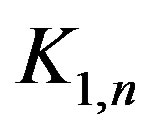1. Introduction
In this paper we shall use the terminology of [1]. Let  be a simple graph with vertex set
be a simple graph with vertex set  and edge set
and edge set . Let
. Let ,
, . For every
. For every , the open neighborhood of
, the open neighborhood of , denoted by
, denoted by , is a set
, is a set  and the closed neighborhood of
and the closed neighborhood of , denoted by
, denoted by , is a set
, is a set . We write
. We write  for the degree of a vertex
for the degree of a vertex  and the maximum and minimum degree of
and the maximum and minimum degree of  are denoted by
are denoted by  and
and , respectively. For every
, respectively. For every , the edge-closed neighborhood of
, the edge-closed neighborhood of , denoted by
, denoted by , is
, is
 .
.
Many domination parameters in graphs has been studied richly [2-4] A function  is a signed dominating function if for every vertex
is a signed dominating function if for every vertex
 ,
, .
.
The weight  of
of  is the sum of the function values of all vertices in
is the sum of the function values of all vertices in . The signed domination number
. The signed domination number  of
of  is the minimum weight of signed dominating functions on
is the minimum weight of signed dominating functions on . This concept was introduced by Dunbar et al. [5] and has been studied by several authors [6-9]. As an extension of the signed domination, we give the definition of the reverse total signed vertex domination in a graph.
. This concept was introduced by Dunbar et al. [5] and has been studied by several authors [6-9]. As an extension of the signed domination, we give the definition of the reverse total signed vertex domination in a graph.
Definition 1. Let  be a simple graph. A reverse total signed vertex dominating function of
be a simple graph. A reverse total signed vertex dominating function of  is a function
is a function  such that
such that 
for all . The reverse total signed vertex domination number of
. The reverse total signed vertex domination number of , denoted by
, denoted by , is the maximum weight of a reverse total signed vertex dominating function of
, is the maximum weight of a reverse total signed vertex dominating function of . A reverse total signed vertex dominating function
. A reverse total signed vertex dominating function  is called a
is called a  -function of
-function of  if
if 
 .
.
2. Properties of Reverse Total Signed Vertex Domination
Proposition 1 For any graph ,
,
 .
.
Proof. Let  be a
be a  -function of
-function of . Then
. Then
 .
.
Let
 ,
,
 ,
,
 ,
,
 .
.
Then
 .
.
Therefore .
.
Propositon 2 For any graph ,
, .
.
Proof. Let  be a
be a  -function of
-function of . Then for every
. Then for every ,
,  and we have
and we have

Thus .
.
Propositon 3 For any graph ,
, .
.
Proof. Let  be a
be a  -function of
-function of .
. ,
,  ,
,  and
and  are defined as Proposition 2. Then
are defined as Proposition 2. Then
 .
.
We define two induced graphs  and
and  of
of  as follows:
as follows:
 ,
,  ,
, .
.
Then for every ,
,

and . For every
. For every , we have
, we have

and . Thus
. Thus

Therefore

Since
 we have
we have . Therefore
. Therefore .
.
Propositon 4 For any star ,
, .
.
Proof. Let  be a
be a  -function. Let
-function. Let
 ,
,
 ,
,
where  is the center of
is the center of . Since for every
. Since for every ,
,  , we have
, we have
 .
.
On the other hand, consider the function

 such that
such that

 ,
,
 .
.
Then  is a reverse total signed vertex dominating function on
is a reverse total signed vertex dominating function on  and
and
 .
.
Thus , which implies that
, which implies that  .
.
Propositon 5 For any circle ,
, .
.
Proof. Let  be a
be a  -function of
-function of . Let
. Let
 ,
, .
.
Since for every ,
, , we have
, we have
 .
.
Thus
 .
.
Therefore .
.
On the other hand, consider the mapping

 such that
such that

 ,
,
 .
.
Then  is a reverse total signed vertex dominating function on
is a reverse total signed vertex dominating function on  and
and . Therefore
. Therefore
 which implies
which implies .
.
Propositon 6 For any complete bipartite graph
 ,
, .
.
Proof. Let be a
be a  -function. Let
-function. Let
 ,
,  ,
,

and
 .
.
Since for every ,
, , we have
, we have  . Therefore
. Therefore
 .
.
On the other hand, consider the mapping

such that ,
,  for
for ,
,
 for
for  and
and . Then
. Then  is a reverse total signed vertex dominating function on
is a reverse total signed vertex dominating function on 
and . Therefore
. Therefore which implies
which implies .
.
3. Acknowledgements
This work was supported by the Natural Science Foundation of Hebei Province (A2012408002), the Educational Commission of Hebei Province (ZH2011122, Z2011157) and Langfang Teachers College (LSZQ201106).